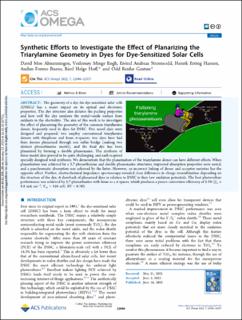| dc.contributor.author | Almenningen, David Moe | |
| dc.contributor.author | Engh, Veslemøy Minge | |
| dc.contributor.author | Strømsodd, Eivind Andreas | |
| dc.contributor.author | Hansen, Henrik Erring | |
| dc.contributor.author | Buene, Audun Formo | |
| dc.contributor.author | Hoff, Bård Helge | |
| dc.contributor.author | Gautun, Odd Reidar | |
| dc.date.accessioned | 2023-01-24T07:48:31Z | |
| dc.date.available | 2023-01-24T07:48:31Z | |
| dc.date.created | 2022-08-09T08:38:14Z | |
| dc.date.issued | 2022 | |
| dc.identifier.citation | ACS Omega. 2022, 7 (25), 22046-22057. | en_US |
| dc.identifier.issn | 2470-1343 | |
| dc.identifier.uri | https://hdl.handle.net/11250/3045625 | |
| dc.description.abstract | The geometry of a dye for dye-sensitized solar cells (DSSCs) has a major impact on its optical and electronic properties. The dye structure also dictates the packing properties and how well the dye insulates the metal–oxide surface from oxidants in the electrolyte. The aim of this work is to investigate the effect of planarizing the geometry of the common triarylamine donor, frequently used in dyes for DSSC. Five novel dyes were designed and prepared; two employ conventional triarylamine donors with thiophene and furan π-spacers, two dyes have had their donors planarized through one sulfur bridge (making two distinct phenothiazine motifs), and the final dye has been planarized by forming a double phenoxazine. The synthesis of these model dyes proved to be quite challenging, and each required specially designed total syntheses. We demonstrate that the planarization of the triarylamine donor can have different effects. When planarization was achieved by a 3,7-phenothiazine and double phenoxazine structures, improved absorption properties were noted, and a panchromatic absorption was achieved by the latter. However, an incorrect linking of donor and acceptor moieties has the opposite effect. Further, electrochemical impedance spectroscopy revealed clear differences in charge recombination depending on the structure of the dye. A drawback of planarized dyes in relation to DSSC is their low oxidation potentials. The best photovoltaic performance was achieved by 3,7-phenothazine with furan as a π-spacer, which produces a power conversion efficiency of 5.2% (Jsc = 8.8 mA cm–2, Voc = 838 mV, FF = 0.70). | en_US |
| dc.language.iso | eng | en_US |
| dc.publisher | American Chemical Society | en_US |
| dc.rights | Navngivelse 4.0 Internasjonal | * |
| dc.rights.uri | http://creativecommons.org/licenses/by/4.0/deed.no | * |
| dc.title | Synthetic Efforts to Investigate the Effect of Planarizing the Triarylamine Geometry in Dyes for Dye-Sensitized Solar Cells | en_US |
| dc.title.alternative | Synthetic Efforts to Investigate the Effect of Planarizing the Triarylamine Geometry in Dyes for Dye-Sensitized Solar Cells | en_US |
| dc.type | Peer reviewed | en_US |
| dc.type | Journal article | en_US |
| dc.description.version | publishedVersion | en_US |
| dc.source.pagenumber | 22046-22057 | en_US |
| dc.source.volume | 7 | en_US |
| dc.source.journal | ACS Omega | en_US |
| dc.source.issue | 25 | en_US |
| dc.identifier.doi | 10.1021/acsomega.2c03163 | |
| dc.identifier.cristin | 2041860 | |
| dc.relation.project | Norges forskningsråd: 295864 | en_US |
| dc.relation.project | Norges forskningsråd: 226244 | en_US |
| cristin.ispublished | true | |
| cristin.fulltext | original | |
| cristin.qualitycode | 1 | |

